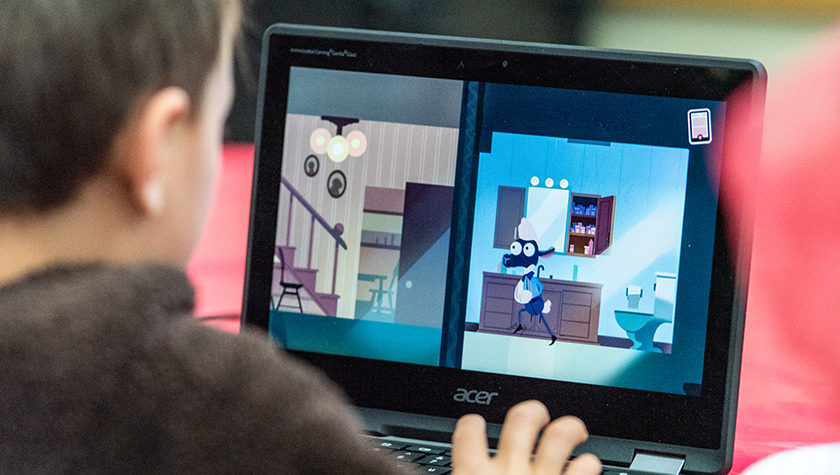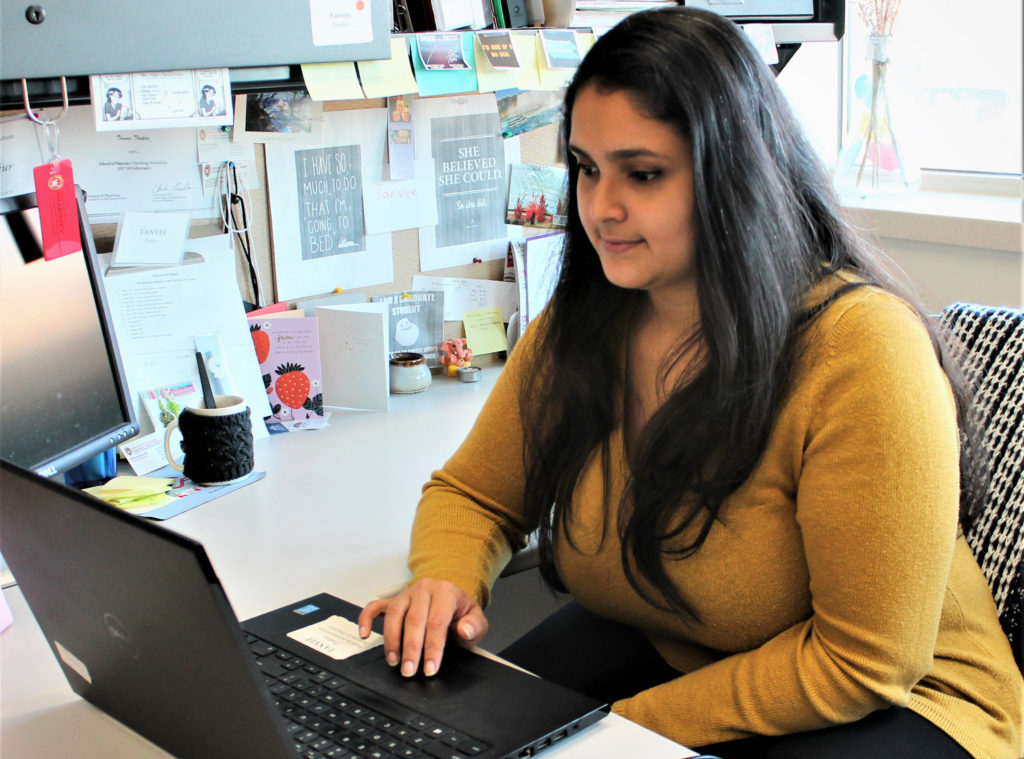
11
December

The last in a three-part series exploring how School of Pharmacy faculty are curbing the opioid epidemic
By Katie Gerhards
Since the late 1990s, the U.S has been embroiled in a battle to reduce opioid misuse and related deaths and so far has made significant progress in reducing opioid prescriptions. Between 2006 and 2018, the rate of opioid prescriptions filled fell by nearly 30 percent, and the annual rate for filling high-dosage opioid prescriptions fell even more dramatically, by more than 66 percent, according to the U.S. Centers for Disease Control.
But even with this progress, the rate of deaths involving prescription opioids has continued to climb an average of 2 percent each year, which speaks to a need for new interventions for prescribing and deprescribing opioid medications, reducing diversion, and treating opioid misuse disorder. Researchers at the University of Wisconsin–Madison School of Pharmacy are on the leading edge of the field, working to protect Wisconsinites’ health.
To share exactly what research aimed at curbing the opioid crisis is underway in the School of Pharmacy, we created this three-part series. In part one, we covered an initiative to arm pharmacists with the tools they need to treat opioid misuse disorder, as well as the groundwork going into a vaccine-based approach to treating opioid misuse.
In part two, we introduced you to a breadth of projects that stretch from enhancing appropriate prescribing to leveraging and empowering pharmacists to increase naloxone dispensing.
In our third and final installment, we’ll discuss a community-engaged project to identify effective interventions, efforts to educate pharmacists and teens alike on issues around opioid use and safety, and a trial for treating opioid misuse disorder with a psychedelic experience.
Community-driven interventions
“You might already know about antibiotic stewardship programs, which help hospitals, health systems, and prescribers use antibiotics appropriately to avoid developing resistance,” says Professor Dave Mott (BS ’88, MS ’92, PhD ’95), chair of the School’s Social and Administrative Sciences Division and William S. Apple Distinguished Chair.
“Opioid stewardship is the same idea,” he says. “Let’s educate providers, educate patients, and develop interventions on a community-wide basis to prevent prescription opioids from being misused.”
That’s the basis of a new collaboration he and Associate Professor Michelle Chui, Hammers Sanders Distinguished Chair in Pharmacy Administration, are developing with Fort Healthcare in Fort Atkinson, Wisconsin. Through a SPER (Stakeholder- and Patient-Engaged Research) grant from the UW Institute for Clinical and Translational Research, the group is reaching out to all facets of the community to identify feasible interventions to reduce opioid misuse.
“Let’s educate providers, educate patients, and develop interventions on a community-wide basis to prevent prescription opioids from being misused.”
—David Mott
“Fort Healthcare, situated in an area of the state with a high opioid-related death rate, is small enough and embedded enough within the community to make a difference on that level, and their strategic organizational priorities are to serve the community,” says Chui.
In that mission, Fort Healthcare had already developed an opioid stewardship committee, which Chui and Mott worked with to build its three stakeholder groups: health care practitioners, community members, and patients. The patient group could include people who have struggled with opioid misuse and their friends and family members, and the community stakeholder group includes representation from the school district, law enforcement, the Drug-Free Coalition, and the Department of Public Health.
“The Sheriff is actually in the community stakeholder group because we want to make sure that when patients enter the legal system, there’s an opportunity for recovery and rehabilitation,” says Chui.
Over the next 12 months, Chui, Mott, and their research collaborators in the School of Pharmacy’s Sonderegger Research Center for Improved Medication Outcomes will meet with each of the three groups to tease out what issues are most important or impactful for each, what feasible solutions might look like, and how they could be implemented. Then, they’ll bring all of the groups together to present an idea for an intervention for feedback and to facilitate conversation between those groups.
“In working with a health system like Fort Healthcare, which has touchpoints in all stages of patient care, there are multiple leverage points we could pursue depending on what our stakeholders think is most important and most feasible,” says Chui. That could mean focusing on conservative approaches for new opioid prescriptions, different ways to manage patients with chronic pain, or how to prevent diversion of opioids or reduce overdose deaths.
“Ultimately, the stakeholder groups are the ones who will be the recipients of whatever intervention we make, and we want to make sure that we’re addressing their needs and goals and that it’s actually doable for all of them,” says Chui.
With that groundwork done, the group can take the top intervention chosen by the stakeholder groups and apply for further grants to implement it and evaluate its impact.
Pharmacist communication and education
Pharmacists are positioned to have a wide-reaching impact on the opioid crisis, from verifying prescriptions to dispensing naloxone and helping patients dispose of unused medications. Tanvee Thakur, PhD candidate in the School’s Health Services Research in Pharmacy PhD program and Joseph Wiederholt Fellow, is exploring ways to improve communication between patients and pharmacists about opioids to ward off problems before they begin.

“In previous studies, Professor Betty Chewning and I found that patients look up to pharmacists as educators about opioid medications, but pharmacists expressed that they didn’t feel they had the resources to have this conversation,” says Thakur, who is writing her dissertation on how Wisconsin pharmacists are approaching and communicating about opioids and their risks.
Specifically, pharmacists Thakur spoke with said that their main barrier was not knowing how to initiate the conversation. Consequently, her research found that most patients weren’t even informed that their pain medications were opioids.
“It’s a sensitive topic because there is so much stigma around opioid use in general, but it’s also an important topic because opioids are prescribed frequently and they carry real risks that patients need and want to understand,” says Thakur.
To create a quick reference for pharmacists to start the conversation, Thakur developed a handout outlining what opioids are, safe practices for storage and disposal, and how to self-monitor pain. With a new grant from the Community Pharmacy Foundation (CPF), Thakur is refining the handout through a statewide survey of around 700 pharmacists, who will weigh in on whether they would use the tool, how they would use it, and how it could be improved.
After the handout, which is also currently being piloted in three pharmacies, is amended with the feedback of Wisconsin pharmacists, it will be available on the CPF website for widespread adoption.
Preventive education in Wisconsin schools
Assistant Professor Olufunmilola Abraham (MS ’11, PhD ’13) is working on a project to start the conversation about opioids well before patients make it to the consultation counter at the pharmacy.
Through a grant from the UW Department of Family Medicine and Community Health, Abraham is visiting schools around Wisconsin to see what students in grades 9 through 12 know about opioid medications and how they want to learn. With that information, Abraham can help school districts intervene and educate to reduce the likelihood that these teens will misuse opioids in the future.
So far, Abraham has conducted surveys and focus groups with nearly 200 Wisconsin students from rural and urban schools and learned, somewhat surprisingly, that students prefer to learn about opioids and misuse by listening to guest speakers discuss their own struggles with drug misuse and the various ways it impacted their life. Another educational approach being explored among teens is the use of digital games.
“A digital game is an interactive hands-on approach that gets them talking, gets them thinking, gets them processing what they’re learning.”
—Olufunmilola Abraham
“Because kids learn differently, we want to have different modalities for reaching students with this information,” says Abraham. “A speaker gives them an emotional connection, but a digital game is an interactive hands-on approach that gets them talking, gets them thinking, gets them processing what they’re learning.”
During the focus groups, Abraham has students design their own video games in small groups, using a whiteboard or flip chart to draw their characters, map out their storyline, and outline the game’s incentives and takeaways. Afterward, the groups present their games to their classmates, who then give feedback on whether they’d play the game and why — or why not.
In addition to giving schools a better idea of how to effectively reach their students with information about safe opioid use, the data Abraham is gathering from these sessions will also be leveraged in her ongoing project to develop a video game that teaches teens about opioid medication safety.
So far, the game, which has been in development since 2018, has been informally tested by nearly 450 people, and after a round of formal pilot testing with schools in 2020, Abraham will be creating a second version of the game incorporating what she’s learned through these focus groups.
“I want us to pilot what we’ve designed, but because we have new data on what Wisconsin teens want to see and what kinds of characters and stories they like, I want to take the information we’ve learned from this study and incorporate it into a second version,” says Abraham. “We want their perspective to be really integral in the design process.”
Potential psychedelic solution to misuse
Psilocybin, a naturally occurring hallucinogenic compound, is seeing a research renaissance as scientists continue to find promise in the drug for treating challenging mental health conditions, such as depression and even addiction.
As other studies examine the compound’s potential to treat dependency on tobacco, cocaine, and alcohol, Professor Paul Hutson is testing its impact on patients undergoing treatment for opioid misuse disorder.
Starting in fall 2019, Hutson and his collaborators at the Department of Family Medicine and Community Health, Christopher Nicholas and Randy Brown, are launching a year-long project that will test the safety of administering psilocybin in tandem with Suboxone®, a combination of buprenorphine and naloxone, in patients who are continuing to struggle with urges to misuse opioids.
Buprenorphine/naloxone helps individuals with opioid misuse disorder mitigate their dependency by preventing symptoms of withdrawal. If Hutson’s study finds that psilocybin is a safe addition to that treatment, the team would move forward to study how successful the two compounds together are in reducing relapses.

“We don’t expect people to come off of buprenorphine/naloxone because we understand that addiction is a lifelong disease. We don’t take people off epilepsy medications, and similarly, this might be something people are taking for the rest of their lives,” says Hutson. “But if psilocybin can reduce their urges to use illicit drugs, we can keep them safer in the long run.”
Participants in the psilocybin trial, identified through ongoing treatment programs, are first thoroughly screened in a two-hour psychiatric examination to check for any risk factors that would disqualify them from the study. Then, participants undergo up to eight hours of preparatory counseling.
During the trial itself, participants would come to a top-of-the-line facility within the School of Pharmacy to receive two doses of psilocybin, administered one month apart. The testing facility, outfitted with recording devices, is fully furnished with all the comforts of home, including a couch, stereo, bathroom, and refrigerator, plus at least one trained individual who will ensure a calm, positive experience.
Afterward, participants are kept overnight at UW Health for ongoing monitoring, and the next morning, they return to the School of Pharmacy for an integration session to discuss what they experienced and examine its significance.
“When used for addiction treatment, psilocybin seems to instill a sense that they’ve seen something greater than themselves and don’t need to abuse tobacco, alcohol, or other substances anymore,” says Hutson. “Although the successes seen to date are preliminary, this could end up being a very effective tool in the fight against opioid dependency and misuse.”




